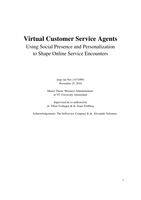Class notes
Virtual Customer Service Agents: Using Social Presence and Personalization to Shape Online Service Encounters
- Course
- Institution
Master's thesis on the role of Virtual Customer Service Agents on the online service experience
[Show more]



